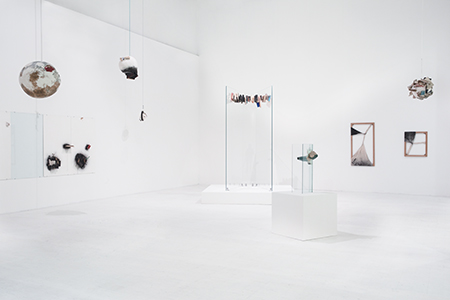John Latham

Ten years ago, when the opening of the John Latham retrospective at Tate Britain was only two months away, the 7th of July bombings in London prompted the removal from the show’s planned inventory of God is Great #2 (1991), a sculpture comprising a large sheet of glass into which Latham had incorporated copies of the Bible, the Koran and the Talmud. The museum issued a statement labelling the work as ‘not appropriate’, given the ‘current sensitive climate’. Latham’s frustrated response, and the ensuing public debate on censorship and freedom of expression, were inevitably on my mind when I started writing this review, a few days after the Charlie Hebdo massacre in Paris. The two episodes are incomparable, of course, but Latham’s lifelong attempt to explain what he called ‘event structure’ – a grand cosmology in which physical reality is not made up of particles but of reiterations of time-based events, a theory that ultimately lead him to a holistic worldview sharply contrasting with the incapacity of major belief systems to co-exist peacefully – suddenly felt very urgent, much broader than art and all the more human. Latham, who died in 2006, worked with books throughout his career – and these were always used, burned, cut, severed volumes that were as perishable, ageing and fragile as human bodies and human knowledge.
The exhibition at La Triennale (curated by Alessandro Rabottini in collaboration with the John Latham Foundation), which was Latham’s first in a public institution in Italy, invited viewers to focus on the artworks per se, as concrete objects and presences, rather than as translations of theoretical constructions. The show’s title, ‘John Latham: Great Noit’ (‘noit’ is Latham’s own coinage, which in reverse reads as the suffix ‘-tion’, referencing a historical continuum) may suggest the framework of a comprehensive retrospective but, in fact, this exhibition was not one, since ample sections of Latham’s work were missing. Only a single vitrine, for instance, included documentation of his performances and happenings, and there was no trace of his involvement in the renowned Artists Placement Group, which he founded with his wife, artist Barbara Steveni (among others), in the mid-1960s. The cross-disciplinary approach of the ‘incidental person’, as Latham defined himself, was supplanted in favour of his output as a visual artist only. As limiting as such a perspective may seem, it brings to the forefront the artworks as material objects, hence rendering them, inevitably, ‘dated’. On the other hand, seen today, Latham’s fascination with the imperfect transmission of information and his appropriation of its props – from the printed page to metal fragments, electric cables, wires and pipes – appears visionary and, at points, eerily close to the formal repertoire of the post-internet generation.
The show opened with two early paintings (Sleep, 1955, and Untitled, 1956) in emulsion and spray paint (the artist’s signature media), followed by a series of assemblages in which books are stuck onto the pictorial plane, somewhat reminiscent of Rauschenberg’s ‘Combine’ paintings (1954–64). In homage to El Greco’s ascendant compositions, one of Latham’s favourite art-historical references, Shaun (1958) is a vertical combination of burnt objects (metal fittings, a ventilator) and book pages, congested at the bottom and sparse at the top. Observer I (1959) reveals an interesting connection: it was bought when Latham exhibited at Milan’s Galleria L’Ariete in a survey-cum-prize organized by critic Pierre Restany who, a year later, gave official birth to nouveau réalisme, again in Milan. The city’s postwar art scene was attuned to the discourses to which both Latham and Restany contributed: Lucio Fontana founded spatialism, and the movimento arte nucleare (nuclear art movement) was expanding. Latham staged his Skoob (‘books’, backwards) Towers Ceremony in London in 1966, for the ‘Destruction in Art’ symposium; four years later, in Milan, Jean Tinguely celebrated the 10th birthday – and funeral – of nouveau réalisme by burning a giant, phallus-shaped column in front of the city’s cathedral.
The exhibition’s second room chronicled the transition of Latham’s painting into lighter, more abstract forms, in which colourful, spray-painted geometric patterns drift across milky-white grounds. A title like Painting not out of a Book (1963) seems almost self-mocking, while Untitled (Roller Painting) (1964) – an elongated painting wrapped around a horizontal pole, so that it can be unrolled mechanically like a window blind and thus be in constant flux – brings into play another key dimension: time. From moving paintings, Latham naturally shifted to moving images: Erth (1971), a 16mm film that was presented as a video projection, visualizes the cosmic distance between humankind and outer space; Encyclopedia Britannica (1971), which was displayed on a monitor, comprises a stop-motion sequence of entire volumes of the encyclopedia. Compressed into six minutes, the overlapping of over-exposed pages makes this ‘enlightened sum of truth’ seem ultimately obscure. A sequence of small monitors showed three beautiful animated short films that use hypnotic flicker/strobe effects: Unedited Material from the Star (1960), Talk Mr Bard (1961) and Speak (1962), which were all screened as backdrops to Pink Floyd’s first live sets in London in 1966 and ’67.
In the third and final room, in which most works were suspended or appeared to levitate, the upward progression of the exhibition reached its climax. From the ceiling hung nine sculptures of the series ‘Cluster of Eleven’ (1992), a solar system of round agglomerates of plaster, books, paint and tubes that mimicked the shape of small planets. A row of closed books, inserted atop a glass sheet to form a freestanding sculpture, seemed on the verge of collapsing, like books about to fall from a shelf. The work’s title, They’re All There (1998), seemed an expression of Latham’s sober registration of, as well as disillusionment with, the fact that despite his life-long efforts to promote an open, inclusive worldview, many belief systems still thrive on narrow-mindedness: the books are all there, but knowledge is fragile, and easily ignored.














